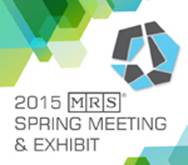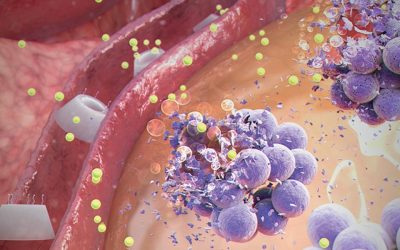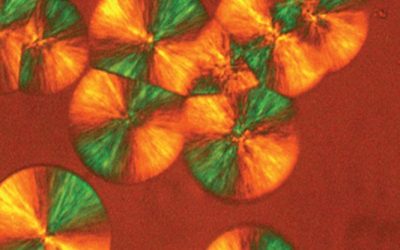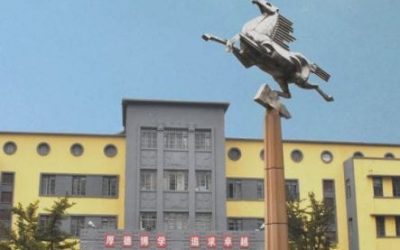 By Martin Preuss and Stefan Hildebrandt
By Martin Preuss and Stefan Hildebrandt
The 2015 Spring Meeting of the Materials Research Society (MRS) took place in San Francisco, California, USA, from April 6 to April 10. With 51 technical symposia, twelve tutorials, poster sessions, more than 120 exhibitors and approximately 5500 registered participants this year’s was again one of the largest MRS Spring Meetings ever.
One thing, of course, was special this year: It was the last MRS Spring Meeting held in San Francisco. From 2016 onwards, it will take place in Phoenix, Arizona. While this may lead to mixed feelings – after all, San Francisco is a spectacular city, and the Moscone Convention Center and the adjacent hotels have been fantastic hosts – this move is also exciting and offers great opportunities for the further development of the meeting in particular and the materials science community in general.
The 51 technical symposia were organized along the lines of the major topical areas “Energy”, “Nanomaterials”, “Electronics and Photonics”, “Soft and Biomaterials”, and “Fabrication and Characterization”. During the coffee and lunch breaks there was sufficient time and possibility to participate in discussions or to explore career opportunities, on top of the usual talks with other attendees. In addition, the poster sessions, accompanied by food and drink, allowed for lively conversations among researchers at the posters and nicely concluded the evenings.
In the symposia dealing with the subject “Energy” it became clear that there is not one solution to reconcile the (conflicting) aspects of rising energy demand, increased focus on sustainability, and the need for a faster commercialization of basic research outcomes.
Eric Lars Miller from the US Department of Energy showed high-level metrics the DoE uses for assessing the performance and potential of fuel cells. He emphasized the need to achieve sustainable hydrogen production for a meaningful large-scale use of fuel cells, and suggested to look for new materials which allow a solar thermal conversion efficiency of 20–25%. If this level of performance can be realized, then hydrogen fuel cell electric vehicles are likely to become cost-competitive with gasoline-powered internal combustion engines, according to a National Petroleum Council Report. The first step towards the mass-market has already been taken: Toyota started the high-volume production of their FCEV model “Mirai” in late 2014, which also attracted the interest of the US Secretary of Energy Ernest Moniz who test drove the car through Washington in early 2015.
Stefaan De Wolf from the École Polytechnique Fédérale de Lausanne, one of the co-organizers of the Tutorial “Silicon and Related Materials for Energy Conversion and Storage”, made a qualitative comparison of the prevalence of different types of solar cells. Crystalline Si-based solar cells currently have the largest market share of 80–90%, followed by thin-film solar cells with a market share of approx. 10–15%. The remaining percentage points are shared by small start-up companies that focus on III–V-based concentrator technology. These figures reflect the high level of maturity of silicon-based photovoltaics both from a fundamental and technological viewpoint, where there might not be much more room for improvement. Therefore alternative approaches to harness the power of the sun, such as perovskite, organic, and dye-sensitized solar cells or novel concepts such as quantum-dot solar cells, are expected to play an increasingly important role in the photovoltaics industry.
Consequently, as at previous MRS meetings, the symposium on organic photovoltaics was among the most popular. Karl Leo of the Technical University Dresden set the scene of this symposium with a comprehensive overview of the current state-of-the-art in organic photovoltaics. Equally popular and complementary to this was the symposium on perovskite-based photovoltaics that Michael Graetzel from the École Polytechnique Fédérale de Lausanne kicked off with a review of metal halide perovskite solar cells. Yang Yang of the University of California Los Angeles pointed out the necessity of improving the basic understanding of perovskite solar cells such as their hysteresis behavior and their stability before combining OPV and perovskite-based photovoltaics to create highly efficient solar cells.
The scientific program of the MRS Fall Meeting was complemented by award and plenary presentations. Oliver Kraft, 2015 MRS President, and Kristi Anseth, 2015 MRS Vice President/President Elect, hosted the Awards and Plenary Ceremony. After thanking MRS officials and volunteers, Oliver Kraft honored the recipients of the MRS Journal of Materials Research Paper of the Year Award and the Graduate Student Award. Kristi Anseth continued with congratulating the MRS Postdoctoral Award and the Outstanding Young Investigator Award, received by Karena W. Chapman of Argonne National Laboratory and Ali Javey of University of California, Berkeley.
Seth Marder of Georgia Tech is this year’s recipient of the Mid-Career Award for “establishing fundamental relationships between the chemical structure of organic molecules and their optical and electronic properties, thereby profoundly impacting how the scientific community designs optimized molecular structures for use in nonlinear optical applications.” In his award talk “Materials for Third-Order Nonlinear Optics” he briefly reviewed the basics of optical non-linearity and the applications based on this effect, e.g., two-photon absorption for 3D microfabrication, 3D optical memories, and non-linear microscopy. Further applications are in the field of optical signal processing, which, however, requires materials with a large ratio of the real and imaginary part of the third-order electric susceptibility. Seth Marder successfully addressed this challenge by exploiting the effect of bond-order alternation in polymers, paving the way for novel device designs and new materials which exhibit the desired optical nonlinearities.
John M. Carpenter of Argonne National Laboratory received the 2015 MRS Innovation in Materials Characterization Award “for innovations in neutron sources that have fundamentally changed their performance and enabled opportunities for further advancement of materials that improve the quality of life.” In his presentation he reviewed the history, development and applications of neutron sources to which he participated strongly during his long career: Among many other breakthrough developments, he is the inventor of the accelerator-based high-intensity pulsed neutron source which is nowadays an indispensable tool for materials characterization. John M. Carpenter pioneered a plethora of instruments to be used in conjunction with neutron sources which today belong to the standard toolbox of every researcher who uses neutrons for the characterization of materials.
Samuel Stupp concluded the Award and Plenary Ceremony with his plenary talk “Bio-Inspiration and Energy Landscapes in Soft Materials Design”. He focused his lecture on supramolecular materials which exhibit superior properties such as the abilities to reconfigure, adapt, order, and respond to external stimuli. Eventually, Samuel Stupp envisions the self-assembly of device structures for photovoltaics.
The 2016 MRS Spring Meeting showed again that materials science is as vibrant as ever, providing insight into fundamental scientific questions, laying the foundation for the commercialization of materials and proposing solutions to some of society’s most pressing matters such as energy demand and sustainability. We can therefore already look forward to the next instalment of the MRS Spring Meeting – remember! – in Phoenix, Arizona, in March and April 2016, and, to bridge the time, to the forthcoming MRS Fall Meeting in Boston just after Thanksgiving.

















